Higher classification Aphelocoma | Scientific name Aphelocoma californica Rank Species | |
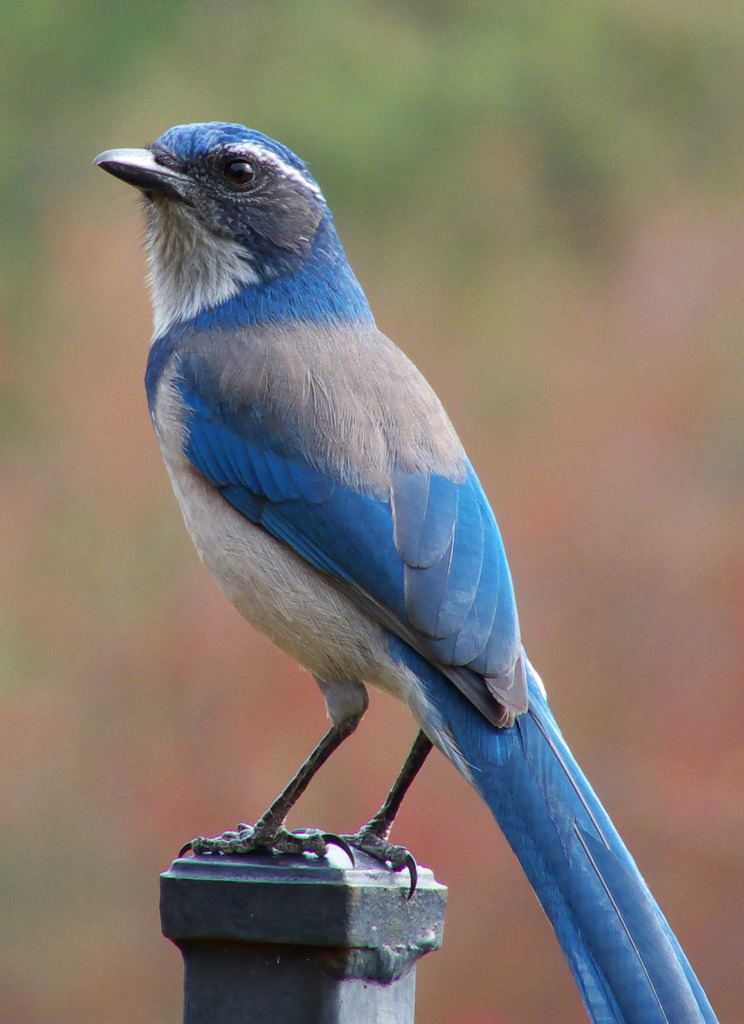 | ||
Similar Bird, Aphelocoma, Florida scrub jay, Steller's jay, Spotted towhee | ||
The California scrub jay (Aphelocoma californica), is a species of scrub jay native to western North America. It ranges from southern British Columbia throughout California west of the Sierra Nevada. The California scrub jay was once lumped with the Island scrub jay, and Woodhouse's scrub jay, collectively called the western scrub jay. The group was also lumped with the Florida scrub jay; the taxon was then called, simply, the scrub jay. The California scrub jay is nonmigratory and can be found in urban areas, where it can become tame and will come to bird feeders. While many refer to scrub jays as "blue jays", the blue jay is a different species of bird entirely. In recent years, the California scrub jay has expanded its range north into the Tsawwassen region of British Columbia.
Contents
- Etymology
- Description
- Habitat
- Foraging
- Food storing
- Intelligence
- Nesting
- Life span
- Diseases
- Phylogeny
- References
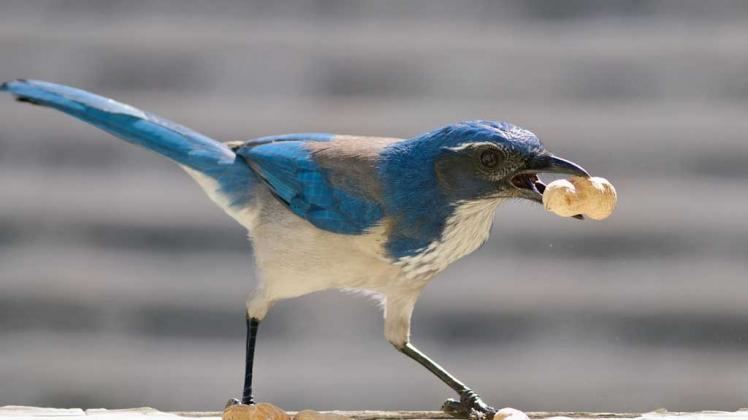
Etymology
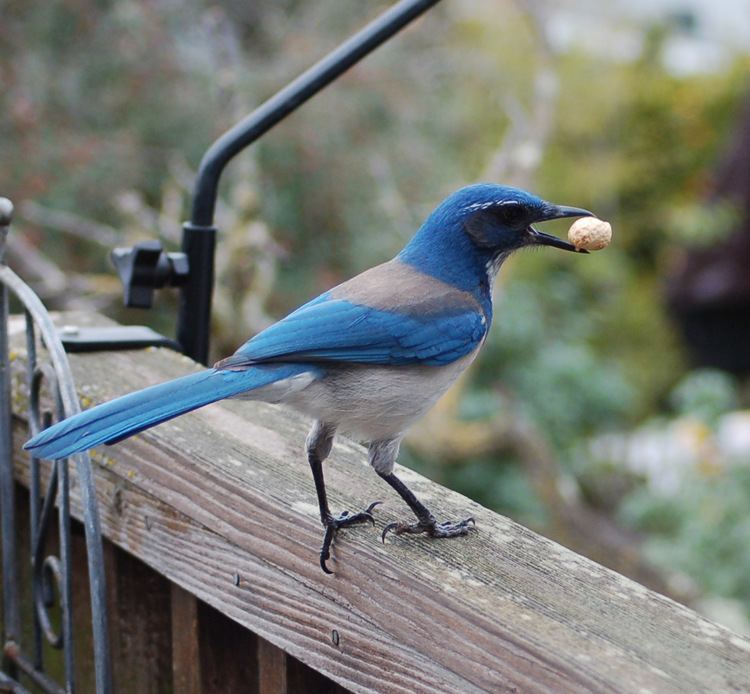
The generic name Aphelocoma derives from Latinized Ancient Greek apheles- (from ἀφελής-) "simple" + Latin coma (from Greek kome κόμη) "hair", in reference to the lack of striped or banded feathers in this genus, compared to other jays. californica, Latin: "from California".
Description
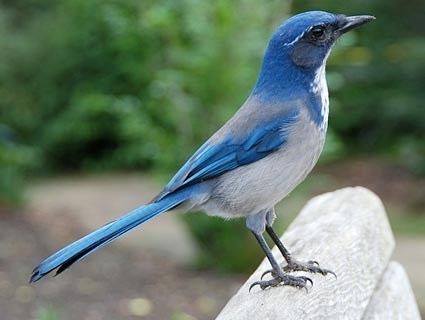
The California scrub jay is a medium-sized bird, approximately 27–31 cm (11–12 in) in length (including its tail), with a 39 cm (15 in) wingspan, and about 80 g (2.8 oz) in weight. In general, this species has a blue head, wings, and tail, a gray-brown back, and grayish underparts. The throat is whitish with a blue necklace. The call is described as "harsh and scratchy".
Habitat
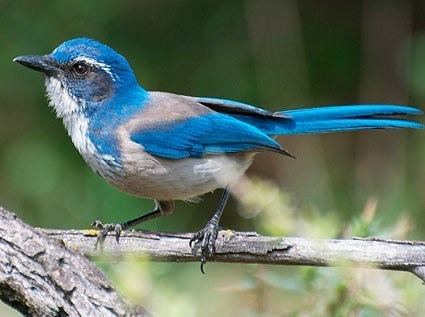
True to its name, the California scrub jay inhabits areas of low scrub, preferring pinon-juniper forests, oak woods, and edges of mixed evergreen forests. It also inhabits suburban gardens.
Foraging
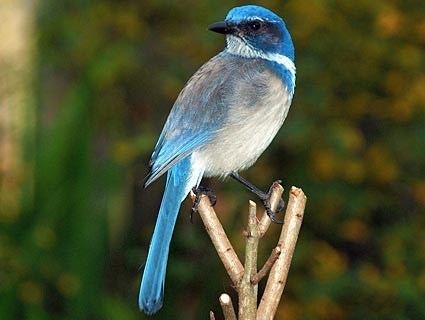
California scrub jays usually forage in pairs, family groups, or small non-kin groups, outside of the breeding season. They feed on small animals, such as frogs and lizards, eggs and young of other birds, insects, and (particularly in winter) grains, nuts, and berries. They will also eat fruit and vegetables growing in backyards.
Food storing
Califormia scrub jays, like many other corvids, exploit ephemeral surpluses by storing food in scattered caches within their territories. They rely on highly accurate and complex memories to recover the hidden caches, often after long periods of time. In the process of collecting and storing this food, they have shown an ability to plan ahead in choosing cache sites to provide adequate food volume and variety for the future. Western scrub jays are also able to rely on their accurate observational spatial memories to steal food from caches made by conspecifics. To protect their caches from potential 'pilferers', food storing birds implement a number of strategies to reduce this risk of theft. Western scrub jays are also known for hoarding and burying brightly colored objects. Western scrub jays have a mischievous streak, and they are not above outright theft. They have been caught stealing Acorns from acorn woodpecker caches. Some scrub jays steal acorns they have watched other jays hide. When these birds go to hide their own acorns, they check first that no other jays are watching.
Intelligence
Recent research has suggested that western scrub jays, along with several other corvids, are among the most intelligent of animals. The brain-to-body mass ratio of adult scrub jays rivals that of chimpanzees and cetaceans, and is dwarfed only by that of humans. Scrub jays are also the only non-primate or non-dolphin shown to plan ahead for the future, which was previously thought of as a uniquely human trait. Other studies have shown that they can remember locations of over 200 food caches, as well as the food item in each cache and its rate of decay. To protect their caches from pilfering conspecifics, scrub-jays will choose locations out-of-sight of their competitors, or re-cache caches once they are alone, suggesting that they can take into account the perspective of others. California scrub jays also summon others to screech over the body of a dead jay, according to new research from the University of California, Davis. The birds' cacophonous "funerals" can last for up to half an hour.
Nesting
The chicks start off fully gray. The older they get, the more they turn blue. On their heads, chicks tend to have a red crest that resembles a comb (Mostly seen on chickens). The chick will lose its crest at day seven, just like the way the baby chickens lose their egg tooth at 5–7 days. Nests are built low in trees or bushes, 1–10 m (3.3–32.8 ft) above the ground, primarily by the female, while the male guards her efforts. The nests are sturdy, with an outside diameter of 33–58 cm (13–23 in), constructed on a platform of twigs with moss and dry grasses lined with fine roots and hair. Four to six eggs are laid from March through July, with some regional variations. There are two common shell color variations: pale green with irregular, olive-colored spots or markings; and pale grayish-white to green with reddish-brown spots. The female incubates the eggs for about 16 days. The young leave the nest about 18 days after hatching.
Life span
The life span of wild California scrub jays is approximately 9 years. The oldest known western scrub jay was found in Castaic, CA, in 1991 and raised in captivity. "Aaron" lived to be 19 years, and 8 months old.
Diseases
Populations are being adversely affected by the West Nile virus, particularly in California's Central Valley.
Phylogeny
Woodhouse's, California, Island, and Florida scrub jay were once considered subspecies of a single "scrub jay" species. They are now believed to be distinct. Beyond the close relationship of the "California" and island scrub jays, resolution of their evolutionary history has proven very difficult.
Woodhouse's scrub jay differ in plumage (paler blue above, with an indistinct and usually incomplete breast band) from California scrub jay which are darker blue above with a strongly defined – but not necessarily complete – blue breast band.
The following subspecies are recognized:
